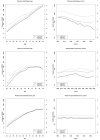Educational Differences in U.S. Adult Mortality: A Cohort Perspective
- PMID: 25346542
- PMCID: PMC4208076
- DOI: 10.1177/0003122412451019
Educational Differences in U.S. Adult Mortality: A Cohort Perspective
Abstract
We use hierarchical cross-classified random-effects models to simultaneously measure age, period, and cohort patterns of mortality risk between 1986 and 2006 for non-Hispanic white and non-Hispanic black men and women with less than a high school education, a high school education, and more than a high school education. We examine all-cause mortality risk and mortality risk from heart disease, lung cancer, and unpreventable cancers. Findings reveal that temporal reductions in black and white men's and women's mortality rates were driven entirely by cohort changes in mortality. Findings also demonstrate that disparate cohort effects between education groups widened the education gap in all-cause mortality risk and mortality risk from heart disease and lung cancer across this time period. Educational disparities in mortality risk from unpreventable cancers, however, did not change. This research uncovers widening educational differences in adult mortality and demonstrates that a cohort perspective provides valuable insights for understanding recent temporal changes in U.S. mortality risk.
Keywords: age-period-cohort; disparities; education; mortality; trends.
Figures





References
-
- Barker DJP. The Origins of the Developmental Origins Theory. Journal of Internal Medicine. 2007;261:412–17. - PubMed
-
- Beckett Megan. Converging Health Inequalities in Later Life: An Artifact of Mortality Selection? Journal of Health and Social Behavior. 2000;41:106–119. - PubMed
-
- Ben-Shlomo Yoav, Diana Kuh. A Life Course Approach to Chronic Disease Epidemiology: Conceptual Models, Empirical Challenges, and Interdisciplinary Perspectives. International Journal of Epidemiology. 2002;31:285–93. - PubMed
-
- Blackwell Debra, Mark Hayward, Eileen Crimmins. Does Childhood Health Affect Chronic Morbidity in Later Life? Social Science and Medicine. 2001;52:1269–84. - PubMed
Grants and funding
LinkOut - more resources
Full Text Sources
Molecular Biology Databases
Miscellaneous
